2021 NISSAN NV200 automatic transmission
[x] Cancel search: automatic transmissionPage 114 of 300

• All doors unlock automatically when thetransmission is placed in the P (Park) po-
sition, when the ignition is turned to the
OFF position, or when the key is removed
from the ignition.
CAUTION
Listed below are conditions or occur-
rences which will damage the key fob:
• Do not allow the key fob, which con-
tains electrical components, to come
into contact with water or salt water.
This could affect the system
function.
• Do not drop the key fob.
• Do not strike the key fob sharply
against another object.
• Do not change or modif y the key fob.
• Wetting may damage the key fob. If
the key fob gets wet, immediately
wipe until it is completely dry.
REMOTE KEYLESS ENTRY SYSTEM (if
so equipped)
3-10Pre-driving checks and adjustments
Page 153 of 300
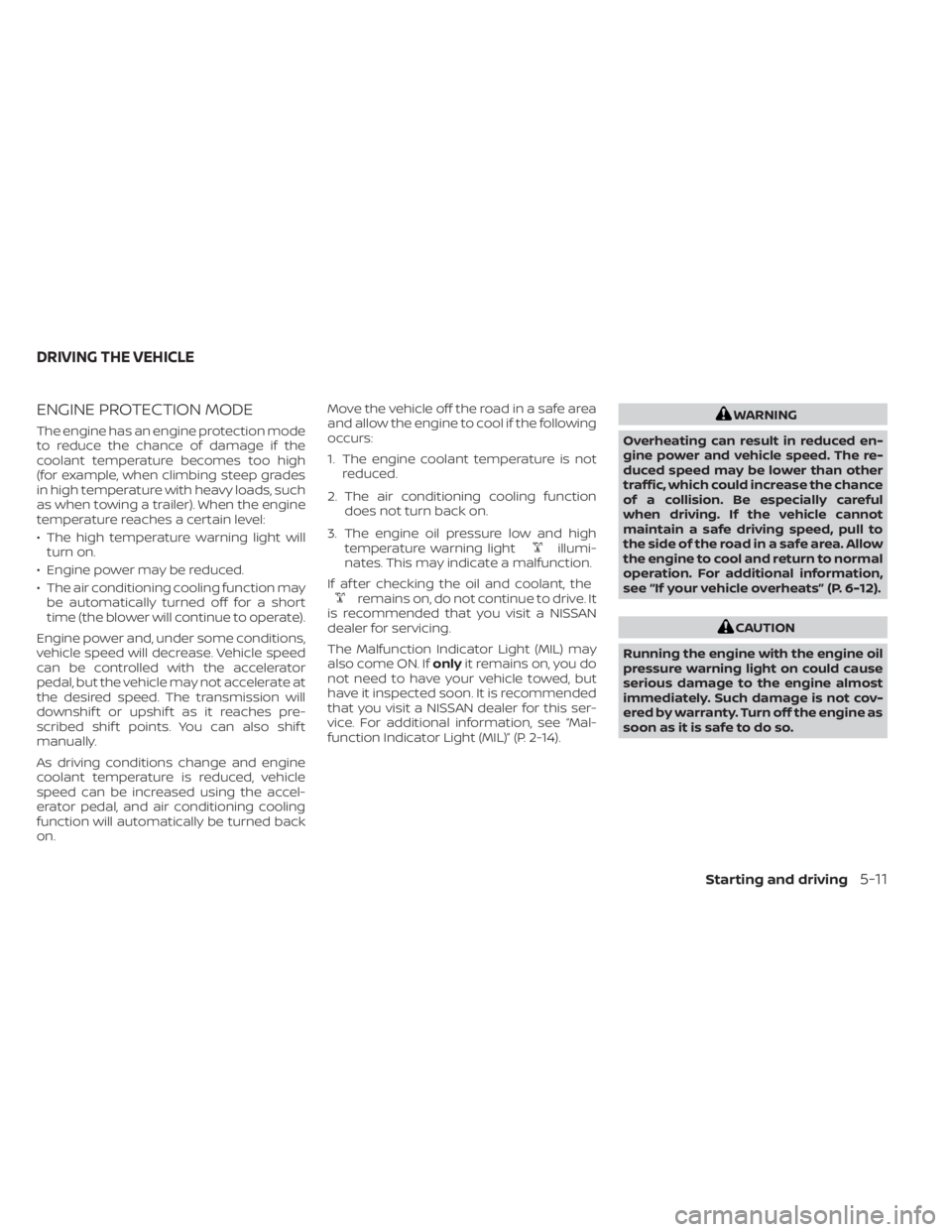
ENGINE PROTECTION MODE
The engine has an engine protection mode
to reduce the chance of damage if the
coolant temperature becomes too high
(for example, when climbing steep grades
in high temperature with heavy loads, such
as when towing a trailer). When the engine
temperature reaches a certain level:
• The high temperature warning light willturn on.
• Engine power may be reduced.
• The air conditioning cooling function may be automatically turned off for a short
time (the blower will continue to operate).
Engine power and, under some conditions,
vehicle speed will decrease. Vehicle speed
can be controlled with the accelerator
pedal, but the vehicle may not accelerate at
the desired speed. The transmission will
downshif t or upshif t as it reaches pre-
scribed shif t points. You can also shif t
manually.
As driving conditions change and engine
coolant temperature is reduced, vehicle
speed can be increased using the accel-
erator pedal, and air conditioning cooling
function will automatically be turned back
on. Move the vehicle off the road in a safe area
and allow the engine to cool if the following
occurs:
1. The engine coolant temperature is not
reduced.
2. The air conditioning cooling function does not turn back on.
3. The engine oil pressure low and high temperature warning light
illumi-
nates. This may indicate a malfunction.
If af ter checking the oil and coolant, the
remains on, do not continue to drive. It
is recommended that you visit a NISSAN
dealer for servicing.
The Malfunction Indicator Light (MIL) may
also come ON. If onlyit remains on, you do
not need to have your vehicle towed, but
have it inspected soon. It is recommended
that you visit a NISSAN dealer for this ser-
vice. For additional information, see “Mal-
function Indicator Light (MIL)” (P. 2-14).
CAUTION
Running the engine with the engine oil
pressure warning light on could cause
serious damage to the engine almost
immediately. Such damage is not cov-
ered by warranty. Turn off the engine as
soon as it is safe to do so.
DRIVING THE VEHICLE
Starting and driving5-11
Page 154 of 300
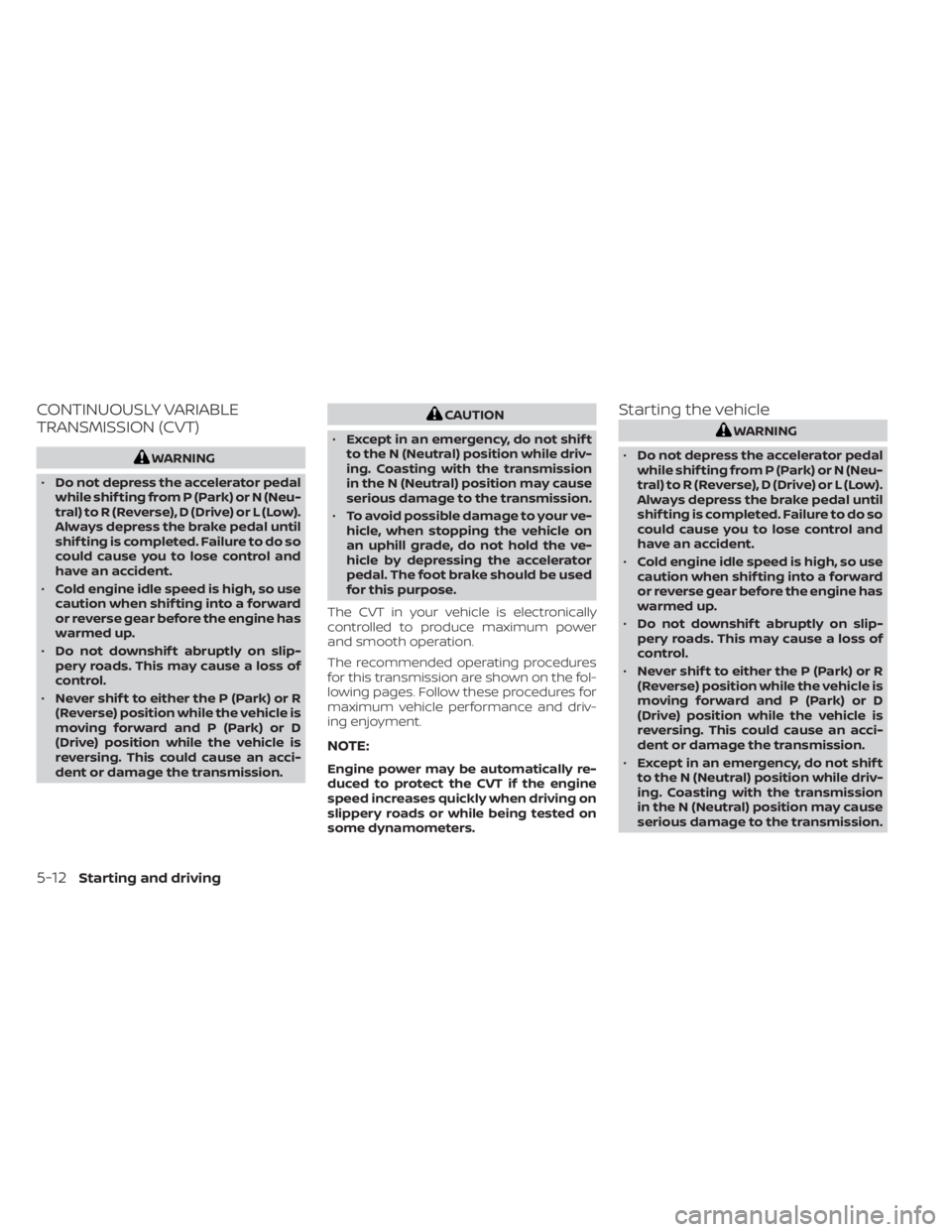
CONTINUOUSLY VARIABLE
TRANSMISSION (CVT)CAUTION
• Except in an emergency, do not shif t
to the N (Neutral) position while driv-
ing. Coasting with the transmission
in the N (Neutral) position may cause
serious damage to the transmission.
• To avoid possible damage to your ve-
hicle, when stopping the vehicle on
an uphill grade, do not hold the ve-
hicle by depressing the accelerator
pedal. The foot brake should be used
for this purpose.
The CVT in your vehicle is electronically
controlled to produce maximum power
and smooth operation.
The recommended operating procedures
for this transmission are shown on the fol-
lowing pages. Follow these procedures for
maximum vehicle performance and driv-
ing enjoyment.
NOTE:
Engine power may be automatically re-
duced to protect the CVT if the engine
speed increases quickly when driving on
slippery roads or while being tested on
some dynamometers.
Starting the vehicle
Page 158 of 300
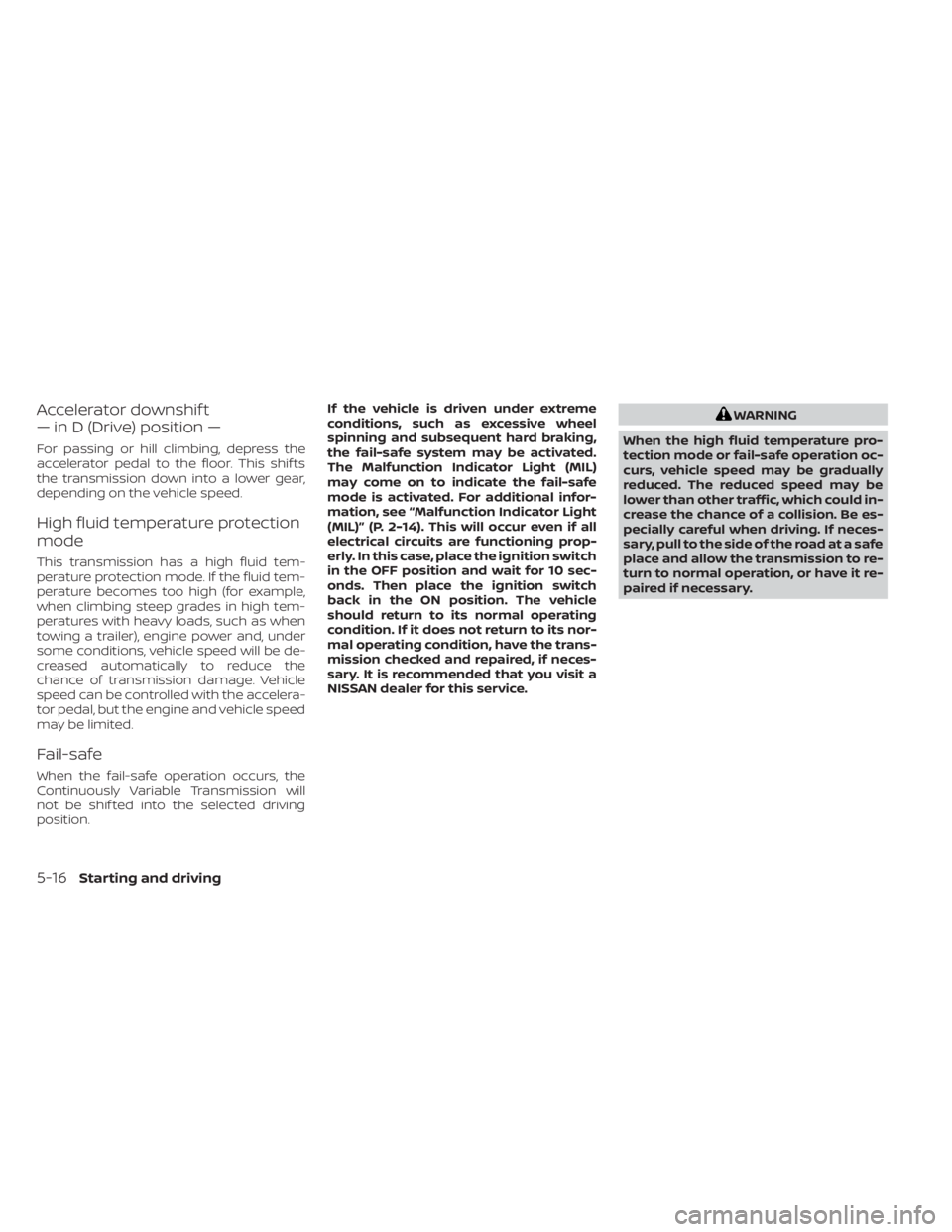
Accelerator downshif t
— in D (Drive) position —
For passing or hill climbing, depress the
accelerator pedal to the floor. This shif ts
the transmission down into a lower gear,
depending on the vehicle speed.
High fluid temperature protection
mode
This transmission has a high fluid tem-
perature protection mode. If the fluid tem-
perature becomes too high (for example,
when climbing steep grades in high tem-
peratures with heavy loads, such as when
towing a trailer), engine power and, under
some conditions, vehicle speed will be de-
creased automatically to reduce the
chance of transmission damage. Vehicle
speed can be controlled with the accelera-
tor pedal, but the engine and vehicle speed
may be limited.
Fail-safe
When the fail-safe operation occurs, the
Continuously Variable Transmission will
not be shif ted into the selected driving
position.If the vehicle is driven under extreme
conditions, such as excessive wheel
spinning and subsequent hard braking,
the fail-safe system may be activated.
The Malfunction Indicator Light (MIL)
may come on to indicate the fail-safe
mode is activated. For additional infor-
mation, see “Malfunction Indicator Light
(MIL)” (P. 2-14). This will occur even if all
electrical circuits are functioning prop-
erly. In this case, place the ignition switch
in the OFF position and wait for 10 sec-
onds. Then place the ignition switch
back in the ON position. The vehicle
should return to its normal operating
condition. If it does not return to its nor-
mal operating condition, have the trans-
mission checked and repaired, if neces-
sary. It is recommended that you visit a
NISSAN dealer for this service.
WARNING
When the high fluid temperature pro-
tection mode or fail-safe operation oc-
curs, vehicle speed may be gradually
reduced. The reduced speed may be
lower than other traffic, which could in-
crease the chance of a collision. Be es-
pecially careful when driving. If neces-
sary, pull to the side of the road at a safe
place and allow the transmission to re-
turn to normal operation, or have it re-
paired if necessary.
5-16Starting and driving
Page 170 of 300
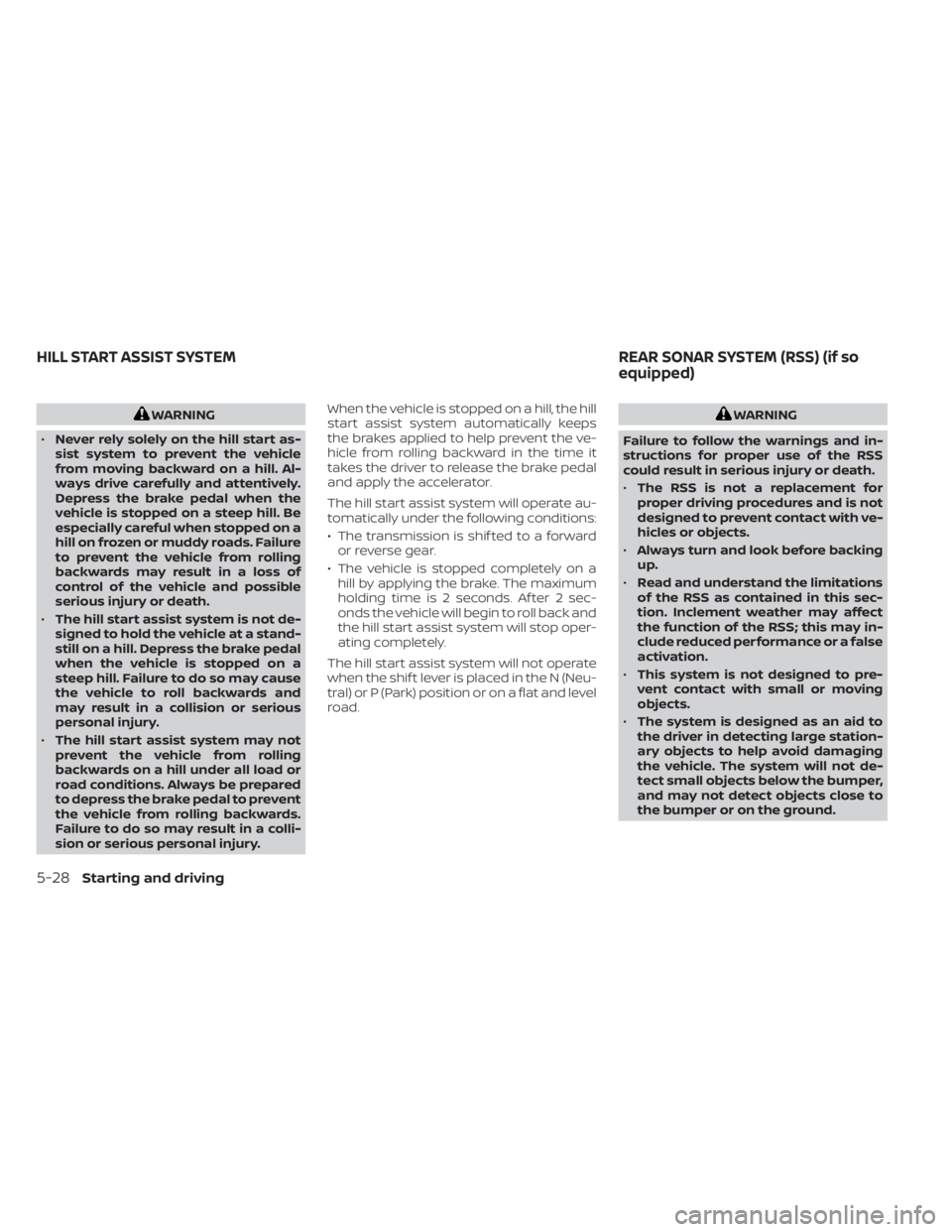
WARNING
• Never rely solely on the hill start as-
sist system to prevent the vehicle
from moving backward on a hill. Al-
ways drive carefully and attentively.
Depress the brake pedal when the
vehicle is stopped on a steep hill. Be
especially careful when stopped on a
hill on frozen or muddy roads. Failure
to prevent the vehicle from rolling
backwards may result in a loss of
control of the vehicle and possible
serious injury or death.
• The hill start assist system is not de-
signed to hold the vehicle at a stand-
still on a hill. Depress the brake pedal
when the vehicle is stopped on a
steep hill. Failure to do so may cause
the vehicle to roll backwards and
may result in a collision or serious
personal injury.
• The hill start assist system may not
prevent the vehicle from rolling
backwards on a hill under all load or
road conditions. Always be prepared
to depress the brake pedal to prevent
the vehicle from rolling backwards.
Failure to do so may result in a colli-
sion or serious personal injury. When the vehicle is stopped on a hill, the hill
start assist system automatically keeps
the brakes applied to help prevent the ve-
hicle from rolling backward in the time it
takes the driver to release the brake pedal
and apply the accelerator.
The hill start assist system will operate au-
tomatically under the following conditions:
• The transmission is shif ted to a forward
or reverse gear.
• The vehicle is stopped completely on a hill by applying the brake. The maximum
holding time is 2 seconds. Af ter 2 sec-
onds the vehicle will begin to roll back and
the hill start assist system will stop oper-
ating completely.
The hill start assist system will not operate
when the shif t lever is placed in the N (Neu-
tral) or P (Park) position or on a flat and level
road.
Page 210 of 300
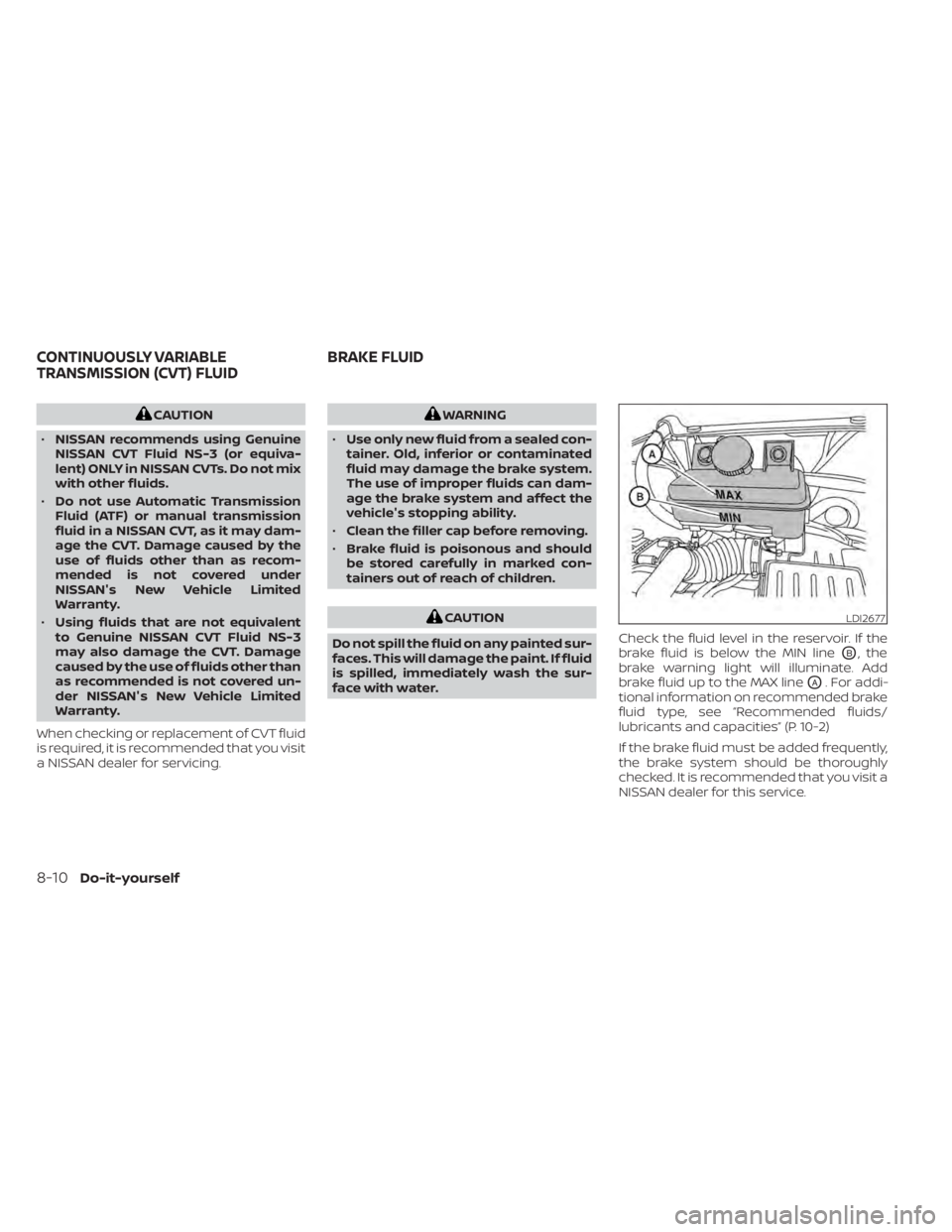
CAUTION
• NISSAN recommends using Genuine
NISSAN CVT Fluid NS-3 (or equiva-
lent) ONLY in NISSAN CVTs. Do not mix
with other fluids.
• Do not use Automatic Transmission
Fluid (ATF) or manual transmission
fluid in a NISSAN CVT, as it may dam-
age the CVT. Damage caused by the
use of fluids other than as recom-
mended is not covered under
NISSAN's New Vehicle Limited
Warranty.
• Using fluids that are not equivalent
to Genuine NISSAN CVT Fluid NS-3
may also damage the CVT. Damage
caused by the use of fluids other than
as recommended is not covered un-
der NISSAN's New Vehicle Limited
Warranty.
When checking or replacement of CVT fluid
is required, it is recommended that you visit
a NISSAN dealer for servicing.
CAUTION
Do not spill the fluid on any painted sur-
faces. This will damage the paint. If fluid
is spilled, immediately wash the sur-
face with water. Check the fluid level in the reservoir. If the
brake fluid is below the MIN line
OB, the
brake warning light will illuminate. Add
brake fluid up to the MAX line
OA. For addi-
tional information on recommended brake
fluid type, see “Recommended fluids/
lubricants and capacities” (P. 10-2)
If the brake fluid must be added frequently,
the brake system should be thoroughly
checked. It is recommended that you visit a
NISSAN dealer for this service.
LDI2677
CONTINUOUSLY VARIABLE
TRANSMISSION (CVT) FLUID BRAKE FLUID
Page 295 of 300
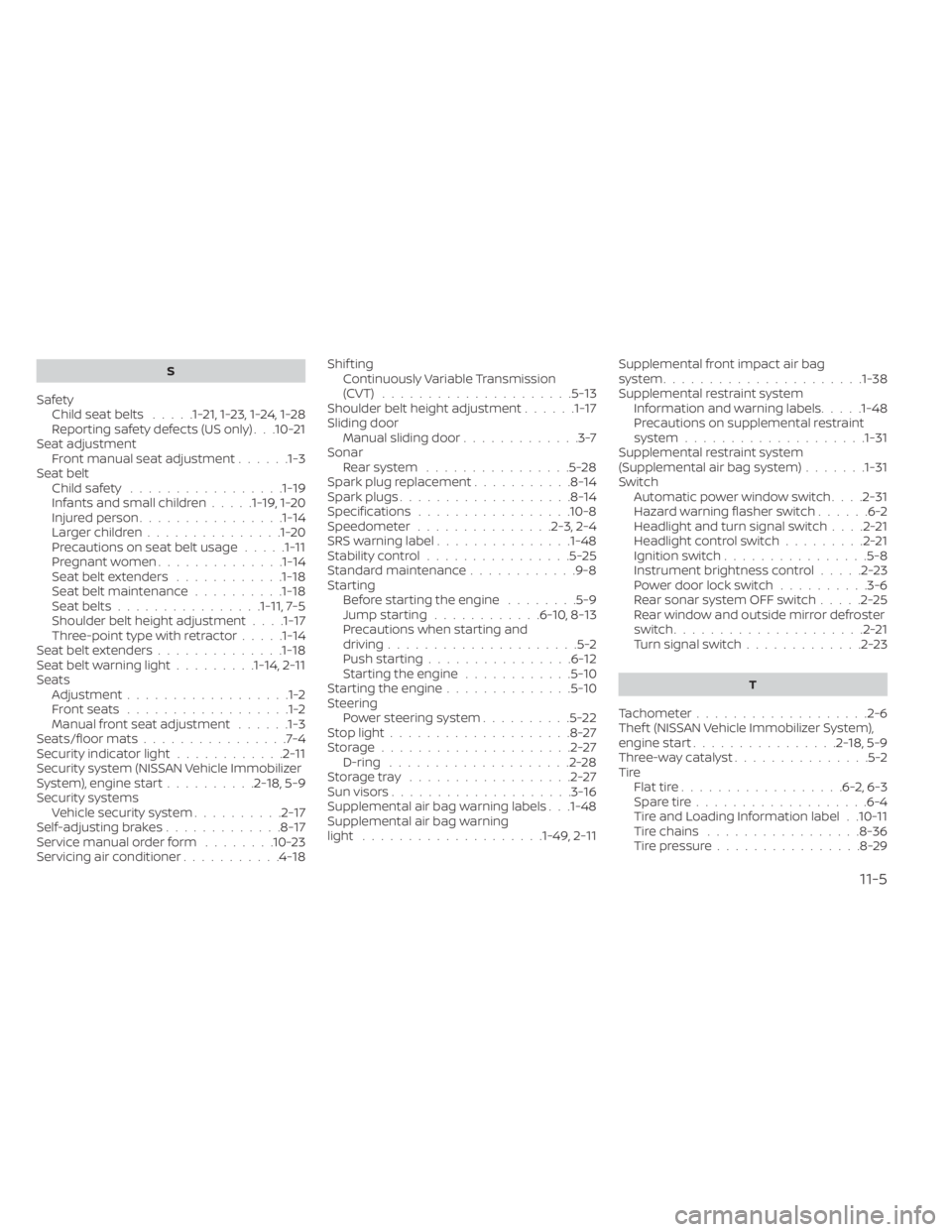
S
SafetyChild seat belts.....1-21,1-23,1-24,1-28Reporting safety defects (US only). . .10-21Seat adjustmentFront manual seat adjustment......1-3Seat beltChild safety.................1-19Infants and small children.....1-19,1-20Injured person................1-14Larger children...............1-20Precautions on seat belt usage.....1-11Pregnant women..............1-14Seat belt extenders............1-18Seat belt maintenance..........1-18Seat belts................1-11,7-5Shoulder belt height adjustment. . . .1-17Three-point type with retractor.....1-14Seat belt extenders..............1-18Seat belt warning light.........1-14,2-11SeatsAdjustment..................1-2Front seats..................1-2Manual front seat adjustment......1-3Seats/floor mats................7-4Security indicator light............2-11Security system (NISSAN Vehicle Immobilizer
System), engine start..........2-18,5-9Security systemsVehicle security system..........2-17Self-adjusting brakes.............8-17Service manual order form........10-23Servicing air conditioner...........4-18
Shif tingContinuously Variable Transmission
(CVT)
.....................5-13Shoulder belt height adjustment......1-17Sliding doorManual sliding door.............3-7SonarRear system................5-28Spark plug replacement...........8-14Spark plugs...................8-14Specifications................ .10-8Speedometer...............2-3, 2-4SRS warning label...............1-48Stability control................5-25Standard maintenance............9-8Starting
Before starting the engine........5-9Jump starting............6-10,8-13Precautions when starting and
driving.....................5-2Push starting................6-12Starting the engine............5-10Starting the engine..............5-10SteeringPower steering system..........5-22Stop light....................8-27Storage.....................2-27D-ring....................2-28Storage tray..................2-27Sun visors....................3-16Supplemental air bag warning labels. . .1-48Supplemental air bag warning
light................... .1-49, 2-11
Supplemental front impact air bag
system..................... .1-38Supplemental restraint system
Information and warning labels.....1-48Precautions on supplemental restraint
system................... .1-31Supplemental restraint system
(Supplemental air bag system).......1-31Switch
Automatic power window switch. . . .2-31Hazard warning flasher switch......6-2Headlight and turn signal switch. . . .2-21Headlight control switch.........2-21Ignition switch................5-8Instrument brightness control.....2-23Power door lock switch..........3-6Rear sonar system OFF switch.....2-25Rear window and outside mirror defroster
switch.....................2-21Turn signal switch.............2-23
T
Tachometer.................. .2-6Thef t (NISSAN Vehicle Immobilizer System),
engine start................2-18,5-9Three-way catalyst...............5-2Tire
Flat tire..................6-2,6-3Spare tire.................. .6-4Tire and Loading Information label. .10-11Tire chains.................8-36Tire pressure................8-29
11-5